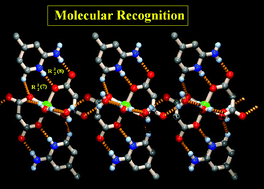Robust recognition of malonate and 2-amino-4-picolinium in conjunction with M(ii) as a triad (M = Ni/Co/Mn): role of this highly stable hydrogen-bonded motif in driving supramolecular self-assembly†
Abstract
The crystal lattice of the three isostructural compounds 1–3, (C6H8N2H)2[M(C3H2O4)2(H2O)2]·4H2O (C6H8N2H = protonated 2-amino-4-picoline, M = Ni/Co/Mn, C3H4O4 = malonate dianion; hereafter, malonate) is formed by supramolecular 2D layers. Hydrogen-bonding, π⋯π and lone pair⋯π interactions play crucial role in organizing monomeric [MII(mal)2(H2O)2] units into 2D sheets along the ab plane, through the self-association between two different supramolecular building blocks, namely a tetrameric water cluster including metal-coordinated water molecules, and R22(8) and R22(7) hydrogen-bonded recognition synthons between 2-amino-4-picolinium and malonate. DFT calculations clearly show that the robust 2-amino-4-picolinium/malonate hydrogen-bonded motif drives the self-assembly of the supramolecular network observed.


 Please wait while we load your content...
Please wait while we load your content...